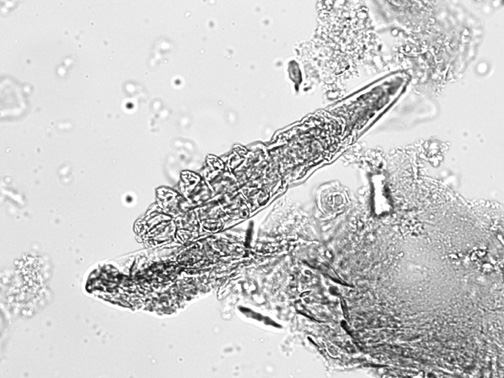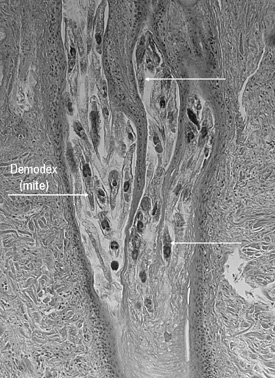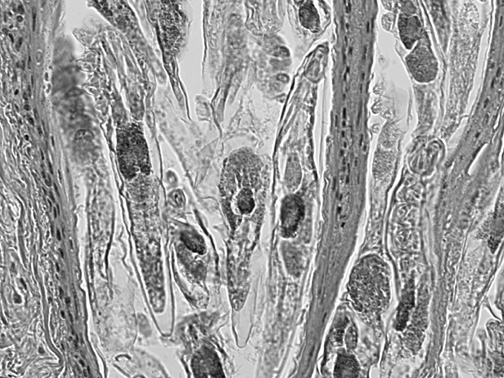| | Life cycle | How does Demodex harm cattle | Can cattle get Demodex from other animals | Knowing when cattle have Demodex | How to be sure cattle have Demodex | Treating affected animals
Demodectic mange is caused by a microscopic mite, Demodex bovis (Figure 1), which lives in hair follicles and associated glands of cattle. Infestation with Demodex is common in cattle. Some 10 to 15 per cent of the cattle in Alberta have Demodex, but most do not develop signs of mange.

Figure 1. Demodex mite released from a hair follicle.
Life Cycle
The life cycle of Demodex takes from 18 to 24 days to complete. During this time, the mite develops through five stages from egg to adult.
The female lays her eggs in the hair follicle. When the egg hatches, it releases a larva that subsequently develops through two nymphal stages before developing into either a male or female mite. The male usually dies three to five days after fertilizing the female.
How Does Demodex Harm Cattle?
Demodex bovis occurs in limited numbers on many healthy cattle (Figure 2). This mite rarely causes problems unless the mite population in the hair follicles increases dramatically. When this situation happens, the hide can be damaged.

Figure 2A. Demodex mites in a hair follicle.

Figure 2B. Demodex mites in a hair follicle (enlarged view of Figure 2A).
Mites feed by puncturing host cells and sucking out the cell contents. This activity results in hair loss and damage to the follicles. In addition, small papules (nodules) can develop in the skin. The nodules vary in size from that of a pinhead to pea-size or, in some cases, even larger (up to 3 cm across).
The number of papules varies. In some cases, only a few are present; in others, several hundred or even thousands occur.
Papules generally appear on the face, neck and shoulders of cattle, but can occur over the entire body. A thick, dirty white to yellow waxy material can be squeezed from the papules. This material contains many microscopic mites. Occasionally, the nodules become filled with pus and join together to form larger abscesses.
Can Cattle Get Demodex From Other Animals?
Over 60 species of Demodex have been identified, and more remain to be discovered. These mites are host specific. Mites from one host will not transfer to a different host species. Many mammals are infected with more than one species of Demodex.
Knowing When Cattle Have Demodex
Demodex bovis cause a variety of clinical signs. These signs range from a few small areas of partial hair loss (localized demodicosis) to extensive regions of hair loss (generalized demodicosis). Lesions first appear on the head and forelimbs and may spread over the entire body.
Papules may first appear as flat nodules in the skin and progress to enlargement of the sebaceous glands containing many mites. The nodules can be detected by running your hand over the skin of the cow.
How to be Sure Cattle Have Demodex
Diagnosis is confirmed by finding the mite during microscopic examination of deep skin scrapings of the affected area. Scrapings must be deep enough to cause oozing or bleeding. Nodules may be cut open and their contents squeezed out. Microscopic examination of this material should reveal thousands of mites in all stages of development.
In some cases, the scrapings or nodule contents may not contain mites. You may have to repeat your sampling procedure three to five times to obtain a diagnosis.
Treating Affected Animals
Several drugs are on the market that are effective against Demodex. Contact your veterinarian for advice on the most suitable drug and treatment program.
Prepared by:
Murray J. Kennedy, Ph.D.
Food Safety Division
Source: 663-33. Revised July 2005. |
|